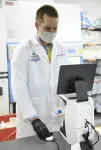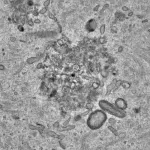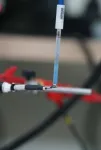(Press-News.org) Smiling for just a split second makes people more likely to see happiness in expressionless faces, new University of Essex research has revealed.
The study led by Dr Sebastian Korb, from the Department of Psychology, shows that even a brief weak grin makes faces appear more joyful.
The pioneering experiment used electrical stimulation to spark smiles and was inspired by photographs made famous by Charles Darwin.
A painless current manipulated muscles momentarily into action – creating a short uncontrollable smile.
This is the first time facial electrical stimulation has been shown to affect emotional perception.
Dr Korb hopes the research can explore potential treatments for depression or disorders that affect expression, like Parkinson’s and autism.
He said: “The finding that a controlled, brief and weak activation of facial muscles can literally create the illusion of happiness in an otherwise neutral or even slightly sad looking face, is ground-breaking.
“It is relevant for theoretical debates about the role of facial feedback in emotion perception and has potential for future clinical applications.”
Dr Korb used a modernised version of a technique first developed in the 19th century by the French physician Duchenne de Boulogne.
Darwin published drawings of Duchenne’s work in The Expression of the Emotions in Man and Animals – his third major work on evolution.
However, the voltage was dialled down for the new experiments to ensure the safety of participants and better control the smiles.
By using computers, the team were able to control the onset of smiles with millisecond precision.
In total 47 people took part in the Essex study which was published in Social Cognitive and Affective Neuroscience.
They were shown digital avatars and asked to assess whether they looked happy or sad. In half the trials, smiling muscles were activated at the onset of the face.
It emerged that producing a weak smile for 500 milliseconds was enough to induce the perception of happiness.
Dr Korb says the results help us understand facial feedback and he hopes to expand the study.
He said: “We are currently conducting more al research to further explore the phenomenon in healthy participants.
“In the future, however, we hope to apply this technique to explore facial emotion recognition, for people with conditions like Parkinson’s, who are known to have reduced spontaneous facial mimicry and impaired facial emotion recognition.
“Moreover, we have published guidelines to allow other researchers to safely start using electrical facial muscle stimulation.”
END
Smiling is the secret to seeing happiness, new research reveals
2024-02-20
ELSE PRESS RELEASES FROM THIS DATE:
Antil studying efficient algorithms for optimization problems with PDE constraints
2024-02-20
Harbir Antil, Professor, Mathematical Sciences; Director, Center for Mathematics and Artificial Intelligence (CMAI), received funding for the project: “Efficient Algorithms for Optimization Problems with PDE Constraints.”
Antil and his collaborators are examining generic optimization problems constrained by partial differential equations (PDEs) with or without uncertainty. In case of uncertainty, a risk-averse optimization framework will be developed. Decomposition and Compression techniques will be utilized to overcome the high computational costs. Several applications in various disciplines such ...
Age-related changes in fibroblast cells promote pancreatic cancer growth and spread
2024-02-20
Older people may be at greater risk of developing pancreatic cancer and have poorer prognoses because of age-related changes in cells in the pancreas called fibroblasts, according to research led by investigators from the Johns Hopkins Kimmel Cancer Center, the Johns Hopkins Bloomberg School of Public Health and the Bloomberg~Kimmel Institute for Cancer Immunotherapy.
The study, published online Feb. 8 in Cancer Research, provides clues as to why pancreatic cancer is more common and aggressive in older people. It may also help scientists develop ...
University of Birmingham signs pioneering collaboration agreement with Vital Energi
2024-02-20
The University of Birmingham has signed a collaboration agreement with Vital Energi to develop and commercialise a range of innovative thermal storage solutions, which will help accelerate decarbonisation within the heating and cooling sector.
The University and Vital Energi will work together over an initial four years to continue the development of thermal storage Intellectual Property (IP) with a view to bringing a number of products to market. As part of the agreement, the University has assigned several IP rights, including a number of patents, to Vital Energi.
The implementation of thermal energy storage is imperative to address the challenges posed ...
Oocytes outsmart toxic proteins to preserve long-term female fertility
2024-02-20
Oocytes are immature egg cells that develop in almost all female mammals before birth. The propagation of future generations depends on this finite reserve of cells surviving for many years without incurring damage. In mice, this can be a period of up to eighteen months, while in humans it can last almost half a century, the average time between birth and menopause. How the cells accomplish this remarkable feat of longevity has been a longstanding question.
Researchers at the Centre for Genomic ...
The Radcliffe Wave is waving
2024-02-20
A few years ago, astronomers uncovered one of the Milky Way’s greatest secrets: an enormous, wave-shaped chain of gaseous clouds in our sun’s backyard, giving birth to clusters of stars along the spiral arm of the galaxy we call home.
Naming this astonishing new structure the Radcliffe Wave, in honor of the Harvard Radcliffe Institute, where the undulation was originally discovered, the team now reports in Nature that the Radcliffe Wave not only looks like a wave, but also moves like one – oscillating through space-time much like “the wave” moving through a stadium full of fans.
Ralf Konietzka, the paper’s ...
Examining excess mortality associated with the pandemic for renters threatened with eviction
2024-02-20
About The Study: Housing instability, as measured by eviction filings, was associated with a significantly increased risk of death over the first 20 months of the COVID-19 pandemic in this study that included 282,000 renters who received an eviction filing. Eviction prevention efforts may have reduced excess mortality for renters during this period.
Authors: Nick Graetz, Ph.D., of Princeton University in Princeton, New Jersey, is the corresponding author.
To access the embargoed study: Visit ...
Fresh meat: New biosensor accurately and efficiently determines meat freshness
2024-02-20
WASHINGTON, Feb. 20, 2024 — The freshness of animal meat is an essential property determining its quality and safety. With advanced technology capable of preserving food for extended periods of time, meat can be shipped around the globe and consumed long after an animal dies. As global meat consumption rates increase, so too does the demand for effective measures for its age.
Despite the technological advances keeping meat fresh for as long as possible, certain aging processes are unavoidable. Adenosine triphosphate (ATP) ...
Large, diverse genetic study of glaucoma implicates vascular and cancer-related genes
2024-02-20
An international genetic study using multiancestry biobanks has identified novel genetic locations associated with primary open-angle glaucoma (POAG), the most common type of glaucoma and the leading cause of irreversible blindness globally. The findings, published Feb. 20 in Cell Reports Medicine, detail ancestry- and sex-specific genetic loci associated with POAG and implicate vascular and cancer-related genes in POAG risk.
“Although there has been significant progress using genome-wide association studies (GWAS) to explore the genetic pathophysiology of glaucoma in humans, there is still a lack of understanding of the underlying ...
HPV vaccination among young adults before and during the pandemic
2024-02-20
About The Study: The results of this study suggest that human papillomavirus (HPV) vaccination coverage among young adults did not increase during the COVID-19 pandemic compared with prior years. This finding likely reflects pandemic-related disruptions in initiating the HPV vaccine among young adults.
Authors: Kalyani Sonawane, Ph.D., of the Medical University of South Carolina in Charleston, is the corresponding author.
To access the embargoed study: Visit our For The Media website at this link https://media.jamanetwork.com/
(doi:10.1001/jamanetworkopen.2023.56875)
Editor’s Note: Please see the article for ...
Historical redlining, persistent mortgage discrimination, and race in breast cancer outcomes
2024-02-20
About The Study: In a study of 1,764 women with breast cancer, living in a historically redlined area was associated with increased odds of a diagnosis of estrogen receptor–negative breast cancer in non-Hispanic Black women and increased odds of late-stage diagnosis in non-Hispanic white women. Persistent mortgage discrimination was associated with an increase in breast cancer mortality in non-Hispanic white women, and non-Hispanic Black women were more likely to die of breast cancer no matter where they lived.
Authors: Jasmine M. Miller-Kleinhenz, Ph.D., of Emory University in Atlanta, is the corresponding author.
To ...






